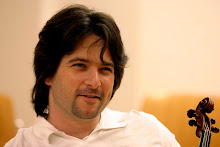I divide the movements we use in playing to "conscious" and "unconscious" (or "aware" and "unaware"). Just like driving a car, there are movements so ingrained in us that we do not think about them in a form of direct command (accelerating, checking the rear view mirror, vibrato, putting fingers in tone and semi tone distance), i.e. we do not tell ourselves "step on the accelerator, shift gear", we simply do it on command.
I use the driving example not only because most of us have experience in it but because in driving and playing the violin, we change our perspective for the same movements when circumstances change. Bad weather, icy road, broken lights in a junction or a police car behind us makes us bring those unconscious movements into the conscious mind. We pause, we slow down, hesitate, evaluate, and become acutely aware of a possible danger, sometimes to the point of making a mistake. Those of us which were unfortunate to need to re take a driving test later in life would know how every movement we used to do without thinking suddenly becomes painfully exposed.
In performing (playing the violin) we go through the same transition of awareness; movements which we did not think twice about executing in the practice room become conscious, non more so (in my experience) then shifting, intonation's greatest threat.
Even once "acclimatized" on stage (after 10 -15 minutes of playing), and fairly more relaxed, a long shift or jump will always come to the forefront of the brain. We'd think about before hand, worry about it, calculate our way towards it, then breathe a silent sigh of relief or utter a curse under our breath, depending on the outcome.
To practice a shift many times is important but this method might also hide false security, since our "motion memory" would correct most shifts on the third or fourth (sometimes even second) try. The problem is that we need to nail it on the first go.
The best test for "first time" is performance practice; a lesson, a class, a private run through or just coming back to the shift in later times during the practice session.
When I miss a shift under these circumstances I try to realize whether the mistake happened because I was not paying attention (shifting unconsciously, throwing the hand with the hope my motion memory would save the day) or was it a conscious shift (I thought I knew exactly where I put the finger down) which was simply in the wrong place.
My advice is first of all never taking any shift for granted while in the safety of the practice room. Work consciously on every single shift, from slow pace to performance speed, with and without vibrato (if vibrato is needed), always aiming to the target, asking yourself not only what went wrong when it happens but also what you are doing right when the playing the shift correctly. If during the performance you manage to relax to the point where shifts become subconscious again, well, lucky you, but I would prepare for worst case scenario when it comes to shifting.
The awareness of what went right is important because many times shifts fail because of bad body position. When we play it again we subconsciously correct the body position to be more comfortable. The implications for such understanding are obvious.
Be realistic about your shift: prolonging the time between the notes is a good working tool but you should concentrate on adhering to the exact circumstances of the piece (using the same speed, part of the bow, bow direction and articulation).
Pay attention to bow control, many shifts fall from grace because we move the bow too soon.
In practice, do not use vibrato to correct intonation mistakes. In performance: cover cover cover.
And I leave you with this thought: even the best pro basketball player in the world, with thousands of games under his belt, would still aim the ball while shooting to the basket.
Sunday, 24 January 2010
Subscribe to:
Posts (Atom)
